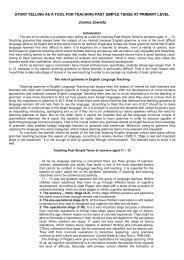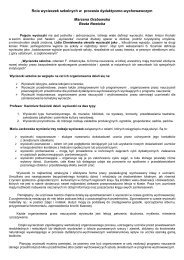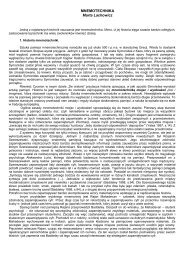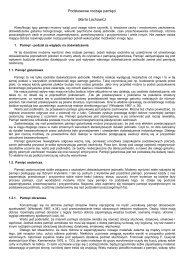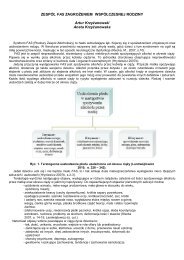On application of visuals in teaching English; selected issues ...
On application of visuals in teaching English; selected issues ...
On application of visuals in teaching English; selected issues ...
Create successful ePaper yourself
Turn your PDF publications into a flip-book with our unique Google optimized e-Paper software.
In this technique students are given a picture and a set <strong>of</strong> sentences. They have to decide which <strong>of</strong> the sentences are<br />
true and which are false rely<strong>in</strong>g on the picture. A variation is to give one picture and three texts conta<strong>in</strong><strong>in</strong>g true and false<br />
<strong>in</strong>formation. Students have to read all three texts, decide what is true and write out a true text. 39<br />
c. Predict<strong>in</strong>g<br />
Students use a picture accompany<strong>in</strong>g a text to predict what the text is about. It is a k<strong>in</strong>d <strong>of</strong> pre-read<strong>in</strong>g task. Before<br />
students beg<strong>in</strong> read<strong>in</strong>g, pictures generate their <strong>in</strong>terest, build confidence and facilitate comprehension.<br />
d. Incomplete picture<br />
Students are given an <strong>in</strong>complete picture (a map for example) and a text with <strong>in</strong>formation about it. They read the text<br />
and draw <strong>in</strong> the miss<strong>in</strong>g parts <strong>of</strong> the picture. 40<br />
e. Sequenc<strong>in</strong>g<br />
Students read a story provided by the teacher and then arrange a number <strong>of</strong> pictures to match the text.<br />
3.3 Other <strong>application</strong>s <strong>of</strong> <strong>visuals</strong><br />
a. Convey<strong>in</strong>g mean<strong>in</strong>g<br />
Some pictures seem to illustrate an object or an action. They are usually very simple and with m<strong>in</strong>imum background.<br />
Such pictures seem to be ideal for expla<strong>in</strong><strong>in</strong>g the mean<strong>in</strong>g <strong>of</strong> words, but this is not the only way <strong>of</strong> <strong>in</strong>troduc<strong>in</strong>g new<br />
vocabulary with the <strong>application</strong> <strong>of</strong> visual aids.<br />
Teacher can present a word by po<strong>in</strong>t<strong>in</strong>g to an object. Real objects make it possible to teach not only nouns but also<br />
other parts <strong>of</strong> speech. They can be touched and manipulated, which provide possibility to <strong>in</strong>troduce new adjectives and<br />
verbs.<br />
Teacher can also use his/her body language to illustrate the mean<strong>in</strong>g <strong>of</strong> a word through gestures and mimes.<br />
New words can be also <strong>in</strong>troduced by giv<strong>in</strong>g them graphical forms which help memorize them. In this technique<br />
students try to give the word a shape which can be easily associated with its mean<strong>in</strong>g.<br />
Good idea is also draw<strong>in</strong>g a diagram. Students are provided with or draw simple sketch or a picture <strong>of</strong> certa<strong>in</strong> object<br />
(for example “a car” or “a men”). They name each element <strong>of</strong> the picture or number them and make a list <strong>of</strong> words used to<br />
name these elements. Such diagram can be used as a k<strong>in</strong>d <strong>of</strong> picture dictionary.<br />
An <strong>in</strong>terest<strong>in</strong>g way <strong>of</strong> expla<strong>in</strong><strong>in</strong>g the mean<strong>in</strong>g <strong>of</strong> word families is draw<strong>in</strong>g ‘word thermometers’. “These are useful for<br />
<strong>in</strong>dicat<strong>in</strong>g degree <strong>in</strong> e.g. size, speed, age, distance, emotion. Students are given a list <strong>of</strong> words <strong>in</strong> jumbled order and they<br />
have to place these words <strong>in</strong> the correct place on the thermometer.” 41<br />
b. Grammar teach<strong>in</strong>g<br />
Andrew Wright writes that “at some stage <strong>in</strong> T/L sequence the teacher will probably want the learner to become<br />
consciously aware <strong>of</strong> the grammatical pr<strong>in</strong>ciple beh<strong>in</strong>d the new language be<strong>in</strong>g learnt.” 42 Visuals help there <strong>in</strong> many ways.<br />
Wright provides an example <strong>of</strong> visual material used for a statement <strong>of</strong> pr<strong>in</strong>ciple. There are two pictures <strong>of</strong> a cat. In the first<br />
one the cat is eat<strong>in</strong>g a fish, <strong>in</strong> the second one there is evidence that the cat has eaten the fish. These pictures are<br />
prepared <strong>in</strong> such way, that they direct the students’ attention and present the differences between the tenses. 43<br />
In tense teach<strong>in</strong>g very common is <strong>application</strong> <strong>of</strong> a time l<strong>in</strong>e. Timel<strong>in</strong>es are used to expla<strong>in</strong> language <strong>in</strong> the more<br />
universal form <strong>of</strong> pictures, diagrams and symbols. They enable the communication <strong>of</strong> sophisticated concepts to the<br />
lowest level <strong>of</strong> learner.<br />
Visuals are also very useful <strong>in</strong> drill<strong>in</strong>g. Practis<strong>in</strong>g description, compar<strong>in</strong>g pictures, nam<strong>in</strong>g, ask<strong>in</strong>g the questions and<br />
answer<strong>in</strong>g them students are us<strong>in</strong>g certa<strong>in</strong> tenses or grammar structures, either <strong>in</strong> a written or spoken form.<br />
c. Ris<strong>in</strong>g awareness <strong>of</strong> phonology<br />
Visuals can be used to help students with their pronunciation, <strong>in</strong>tonation and accent.<br />
Teacher prepares m<strong>in</strong>imal pairs <strong>of</strong> words which can be presented visually. Then s/he presents these words<br />
pronounc<strong>in</strong>g them carefully one by one. Students’ task is to show the picture present<strong>in</strong>g the word teacher is pronounc<strong>in</strong>g<br />
at the moment.<br />
While practic<strong>in</strong>g <strong>in</strong>tonation and stress teacher can also present it visually. S/he uses for example squares <strong>in</strong>stead <strong>of</strong><br />
syllables, where the biggest one means syllable stressed. Such technique is useful also to teach whole sentence melody<br />
and <strong>in</strong>tonation. Teacher can present ris<strong>in</strong>g and fall<strong>in</strong>g <strong>in</strong>tonation us<strong>in</strong>g ris<strong>in</strong>g and fall<strong>in</strong>g <strong>in</strong>dicators or gestures <strong>of</strong> his/her<br />
hand. 44<br />
d. Promot<strong>in</strong>g <strong>in</strong>terest <strong>in</strong> culture<br />
Foreign language is strongly connected with the culture <strong>of</strong> people who use it. For this reason a language teacher<br />
should provide the students with aids which would make this culture more familiar.<br />
There are many objects, customs, habits, places and traditions which are alien to a language learner. To make the<br />
mean<strong>in</strong>g clearer, teacher can use visual images to support the explanation. Visuals and real objects add to the<br />
atmosphere and rem<strong>in</strong>d students that the subject has a great deal to do with life outside the classroom. These can be<br />
pictures, photos, magaz<strong>in</strong>es, post cards, films, brochures and other target-culture <strong>visuals</strong>. Thanks to them lesson is more<br />
<strong>in</strong>terest<strong>in</strong>g and the students aware <strong>of</strong> cultural differences and similarities are more <strong>in</strong>volved <strong>in</strong> target language learn<strong>in</strong>g.<br />
39 Ibid., 165-166.<br />
40 Ibid.,163.<br />
41 Alan Matthews, Mary Spratt and Les Dangerfield, At The Chalkface. Practical Techniques <strong>in</strong> Language Teach<strong>in</strong>g<br />
(Walton-on-Thames Surrey: Thomas Nelson and Sons Ltd, 1991), 186.<br />
42 Wright, “Audio-Visual Materials”, 265.<br />
43 Ibid.<br />
44 Komorowska, Metodyka, 109-110.



